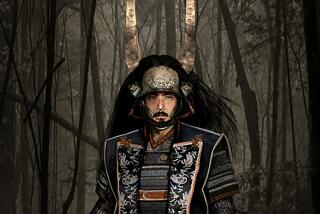Philippine Fabrics Weave Tale of Tenacity
- Share via
The great strength of UCLA’s Fowler Museum of Cultural History is its dedication to demonstrating the interface between art and life. Its latest exhibition throws light on a subject ethnographers themselves regard as complex and confusing.
“From the Rainbow’s Varied Hue: Textiles of the Southern Philippines” was organized by the museum’s curator of Southeast Asia and Oceania, Roy Hamilton, who also edited the scholarly catalog.
The first traveling show ever devoted to the theme, it combines Fowler holdings with turn-of-the-century collections now in New York’s American Museum of Natural History and Chicago’s Field Museum. After its local debut, it moves on to Washington, D.C., and Honolulu.
The ensemble consists of 50 rare fabrics and costumes arranged to emphasize color, design and the complicated symbolic overtones attached to the work. Its makers are the indigenous people of the huge island of Mindanao and the neighboring Sulu Archipelago.
Scholars believe these people arrived in ancient times, migrating from Southeast Asia. Over the centuries, the original Filipinos felt influence from India and the Middle East. A significant percentage converted to Islam in the 15th century. When the Spanish arrived in the 16th century, they found numerous literate groups using the classic Indian writing forms of Pali and Sanskrit.
The flavor of Muslim and Hindu art is still apparent in local variation, attesting to Philippine tenacity in clinging to their ways. It’s been a losing battle. By 1970, invasion, immigration, religious conversion and urbanization had reduced the original inhabitants to a minority in their own land. The traditionalist population--down to a tiny 5%--stuck to their agrarian life in ancestral interior highlands. Muslim sultanates situated in the west and on the archipelago became international trade centers. Gradually this group was whittled down to one-fifth of the population.
Textiles are important to many peoples, but they’re the passion of these folks. Literally thousands of labor-intensive hours went into the making of resplendent wall-hangings and costumes.
Staples of traditional dress are a waist-length jacket-like shirt, knee-length trousers and tubular skirts. These simple prototypes are made magnificent by almost infinitely varied methods of dyeing and embroidered surface decoration. One traditionalist enclave, the Subanen, worked in secret. The curious were kept at bay by the weavers’ reputation as poison experts.
The great epic poem of the Muslim Maranao ascribes virtually magical properties to their textiles. They believe their fabrics can do everything from enticing lovers to healing wounds.
When a turn-of-the-century ethnologist attempted to purchase a cloth, the weaver was afraid of offending its resident soul. The deal was stalled until the spirit was transferred to another fabric.
This art reinvents the arabesque intricacy of ancient prototypes. In one introductory example we see shimmering silk with a prismatic gradation that seems technically impossible. More commonly, these weavers worked wonders with abaca, a hemp-like fiber. The combination lends a casual air to a courtly style.
If it’s roughly correct to say that the cloths of Muslim groups are bolder than more subdued highland examples, it’s more accurate to note that this work is defined more by exception than rule. At one point, for instance, people of the Bukidnon Plateau broke with tradition by substituting commercial patterned cotton for abaca. Always surprising, they cut the cotton into tiny pieces, which they rejoined in original ways. These weavers seem to thrive on complexity.
Costumed mannequins and life-size enlargements of vintage photographs are among the most compelling aspects of the show. Wall labels make reference to particularly elaborate costumes reserved for leaders and heroes. We’re obliquely informed that greater degrees of saturated red cloth were conferred according to the number of enemies killed. Getting the facts straight required a perusal of this catalog plus that of the museum’s 1981 show, “The People and Art of the Philippines.”
Briefly put, a bloody rivalry grew between indigenous Muslims and Spanish colonizers. They wanted to Christianize everybody. Muhammad’s followers wanted to either Islamize or enslave the unconverted hill people. All interested parties fought over that. More trouble ensued when the United States won its war with Spain and gained control in 1898.
Philippine revolutionaries helped the U.S., believing that intervention meant their freedom. When that didn’t pan out, Filipinos started a six-year war, bloodily suppressed by U.S. troops. The Philippines finally gained full independence in 1946.
* UCLA Fowler Museum of Cultural History, through Aug. 23, closed Mondays and Tuesdays, (310) 825-4361.
More to Read
The biggest entertainment stories
Get our big stories about Hollywood, film, television, music, arts, culture and more right in your inbox as soon as they publish.
You may occasionally receive promotional content from the Los Angeles Times.










